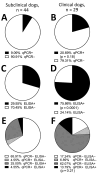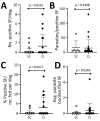Dogs as Reservoirs for Leishmania donovani, Bihar, India, 2018-2022
- PMID: 39592395
- PMCID: PMC11616638
- DOI: 10.3201/eid3012.240649
Dogs as Reservoirs for Leishmania donovani, Bihar, India, 2018-2022
Abstract
Visceral leishmaniasis derived from Leishmania donovani is transmitted by sand flies (Phlebotomus argentipes) throughout the Indian subcontinent. Although considered anthroponotic, L. donovani infects other mammals susceptible to sand fly bites, including dogs. Aggressive strategies to reduce sand fly populations in India have led to flies seeking nonhuman hosts, so understanding the role of dogs in L. donovani transmission has become critical. Our study investigated L. donovani infection in dogs and the potential for such infections to be transmitted back to sand flies. We performed xenodiagnosis by using P. argentipes on dogs (n = 73) with quantitative PCR-detectible parasitemia in both endemic and outbreak villages. We found that 12% (9/73) of dogs were infectious to sand flies during winter and rainy seasons. Patients with visceral leishmaniasis remain primary sources of L. donovani transmission, but our findings suggest a possible link between canine infection and human exposure.
Keywords: India; Leishmania donovani; One Health; Phlebotomus; Xenodiagnosis; dogs; global health; leishmaniasis; parasites; seasonal; transmission; vector-borne infections; zoonoses.
Figures





References
-
- World Health Organization. Leishmaniasis, key facts [cited 2022 Mar 20]. https://www.who.int/news-room/fact-sheets/detail/leishmaniasis
-
- Cameron MM, Acosta-Serrano A, Bern C, Boelaert M, den Boer M, Burza S, et al. Understanding the transmission dynamics of Leishmania donovani to provide robust evidence for interventions to eliminate visceral leishmaniasis in Bihar, India. Parasit Vectors. 2016;9:25. 10.1186/s13071-016-1309-8 - DOI - PMC - PubMed
-
- Kushwaha AK, Tiwary P, Sundar S. Blood meal identification in wild-caught sand flies from the endemic region of visceral leishmaniasis in India. Int J Infect Dis. 2018;73:296. 10.1016/j.ijid.2018.04.4089 - DOI
Publication types
MeSH terms
Grants and funding
LinkOut - more resources
Full Text Sources

